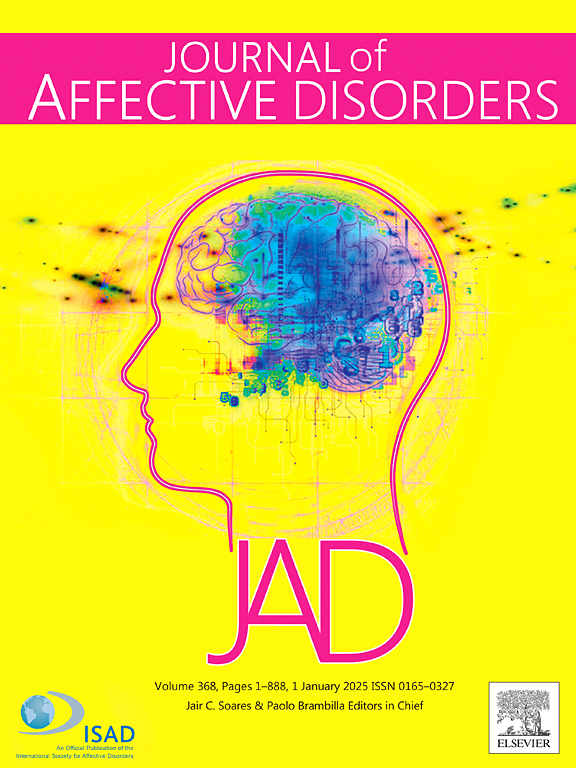氯胺酮对重度抑郁症任务型功能磁共振成像结果的影响:微型综述。
IF 4.9
2区 医学
Q1 CLINICAL NEUROLOGY
引用次数: 0
摘要
背景:在过去二十年里,氯胺酮作为一种治疗重度抑郁症(MDD)的潜在药物,尤其是对传统疗法有抵抗力或自杀风险较高的患者,在精神病学领域获得了极大的关注。基于任务的功能磁共振成像(fMRI)研究可以让人们深入了解氯胺酮是如何改变大脑功能并促进其抗抑郁特性的:本微型综述遵循 MOOSE 观察性研究系统综述指南。我们使用 "重度抑郁障碍"、"氯胺酮"、"esketamine"、"基于任务的fMRI "等关键词和MeSH术语在PubMed、Web of Science和Scopus上进行了文献检索:研究共收录了八篇文章。结果表明,氯胺酮会影响MDD患者的大脑活动,尤其是前扣带回皮层(ACC)、背外侧前额叶皮层和杏仁核。有趣的是,大部分综述研究显示,氯胺酮引起的大脑活动变化与临床抑郁症状的改善之间存在相关性。这些相关性涉及前额叶皮质、ACC和皮质-小脑回路:缺乏氯胺酮对大脑活动持久影响的纵向数据,研究数量较少:本综述确定了关键的研究领域,这些领域可加深对氯胺酮对多发性硬化症患者大脑影响的理解。它呼吁对氯胺酮的作用机制、长期影响、剂量反应优化以及与其他速效抗抑郁药的比较进行研究。解决这些问题可以优化氯胺酮的治疗用途,并揭示新的治疗目标。本文章由计算机程序翻译,如有差异,请以英文原文为准。
Effect of ketamine on task-based functional magnetic resonance imaging findings in major depressive disorder: A mini-review
Background
Over the last two decades, ketamine has gained significant interest in psychiatry as a potential treatment for major depressive disorder (MDD), especially in individuals who are resistant to traditional therapies or are at a high risk of suicide. Task-based functional magnetic resonance imaging (fMRI) studies can provide insight into how ketamine alters brain function and contributes to its antidepressant properties.
Methods
This mini-review followed the MOOSE guidelines for systematic reviews of observational studies. We conducted a literature search in PubMed, Web of Science, and Scopus aiming at identifying fMRI studies investigating the effect of ketamine on brain function in MDD.
Results
Eight articles were included in the study. Results showed that ketamine affects brain activity in MDD, especially in the anterior cingulate cortex (ACC), dorsolateral prefrontal cortex, and amygdala. Interestingly, the majority of the reviewed studies showed a correlation between the changes in brain activity induced by ketamine and improvements in clinical depressive symptoms. These correlations involved the prefrontal cortex, ACC, and cortico-cerebellar circuits.
Limitations
Lack of longitudinal data on the lasting effects of ketamine on brain activity and the small number of studies.
Conclusions
This review identifies key research areas that can enhance our understanding of ketamine's effects on the brain in MDD. It calls for studies on ketamine's mechanisms of action, long-term impact, dose-response optimization, and comparisons with other fast-acting antidepressants. Addressing these areas can optimize ketamine's therapeutic use and reveal new treatment targets.
求助全文
通过发布文献求助,成功后即可免费获取论文全文。
去求助
来源期刊

Journal of affective disorders
医学-精神病学
CiteScore
10.90
自引率
6.10%
发文量
1319
审稿时长
9.3 weeks
期刊介绍:
The Journal of Affective Disorders publishes papers concerned with affective disorders in the widest sense: depression, mania, mood spectrum, emotions and personality, anxiety and stress. It is interdisciplinary and aims to bring together different approaches for a diverse readership. Top quality papers will be accepted dealing with any aspect of affective disorders, including neuroimaging, cognitive neurosciences, genetics, molecular biology, experimental and clinical neurosciences, pharmacology, neuroimmunoendocrinology, intervention and treatment trials.
 求助内容:
求助内容: 应助结果提醒方式:
应助结果提醒方式:


